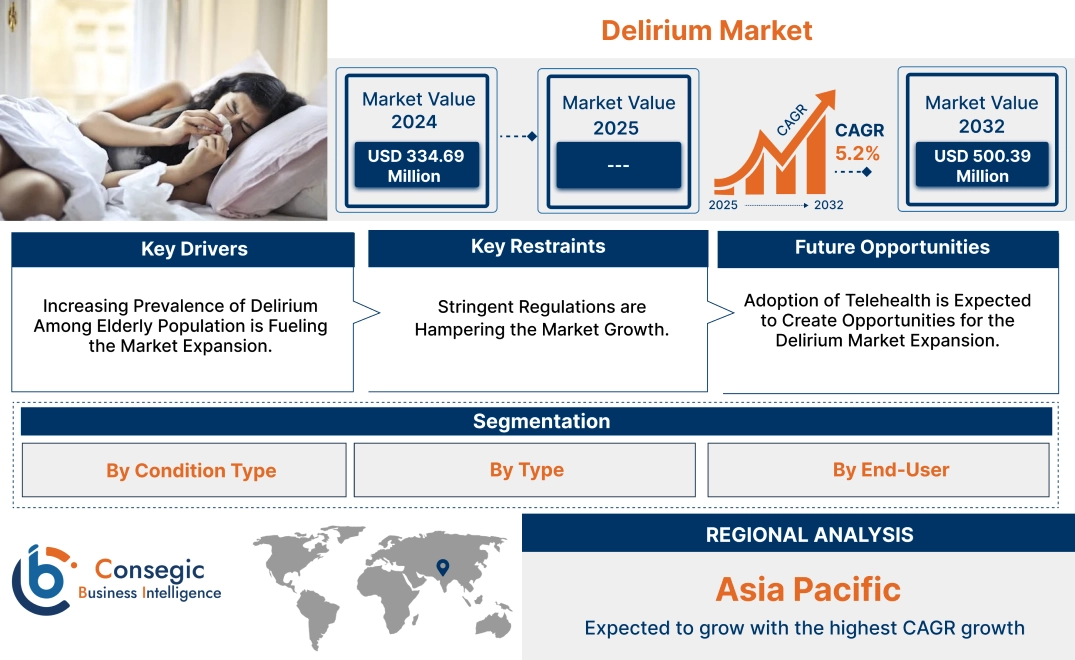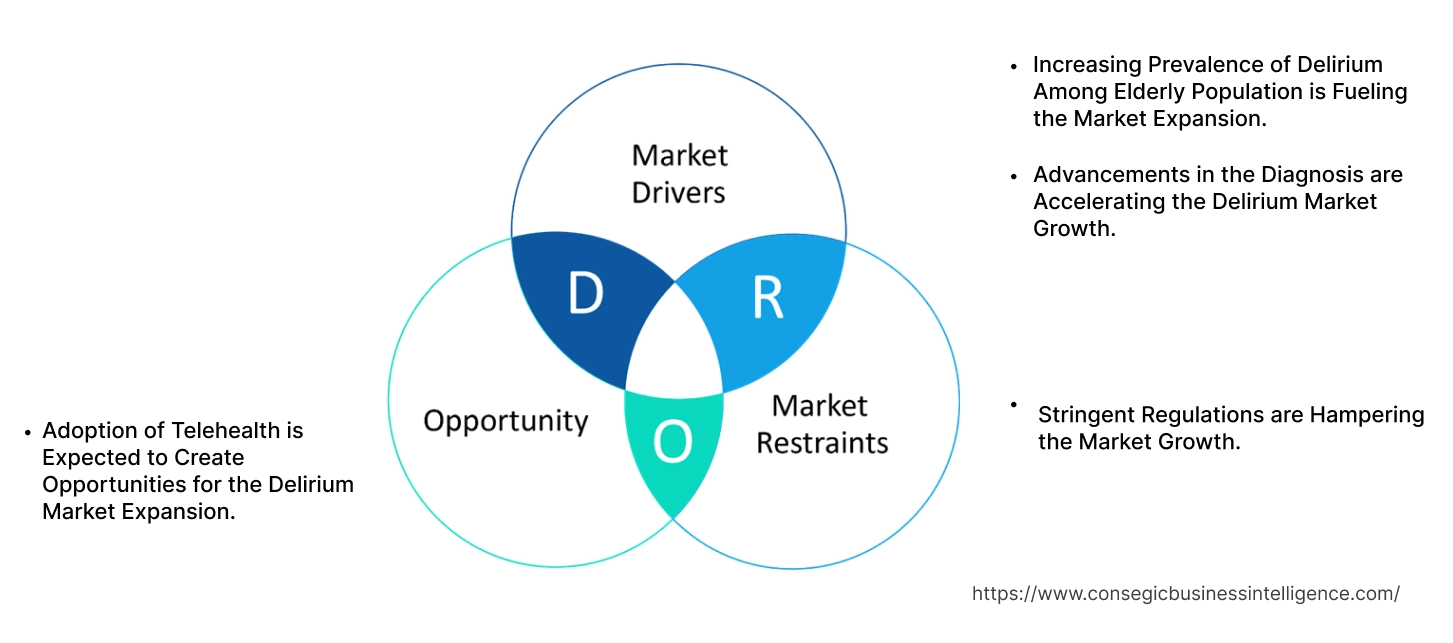- Summary
- Table Of Content
- Methodology
Delirium Market Size:
Delirium Market size is growing with a CAGR of 5.2% during the forecast period (2025-2032), and the market is projected to be valued at USD 500.39 Million by 2032 from USD 334.69 Million in 2024.
Delirium Market Scope & Overview:
Delirium, also known as acute brain failure, is a sudden change in a person's mental state or consciousness. Essentially, this condition reflects a temporary decompensation of cerebral functions, often triggered by one or more underlying pathophysiological processes. The condition is categorized into main 3 types including hypoactive, hyperactive, and mixed type based on psychomotor activity. A hypoactive subtype is dominated by symptoms of drowsiness and inactivity, whereas hyperactive delirium is characterized by restlessness and agitation. This condition is diagnosed using physical exams, neurological exams, laboratory tests, and imaging tests. Its treatment approach encompasses both pharmacological and non-pharmacological management. Pharmacological management includes medications whereas non-pharmacological involves patient orientation and supportive care. This transient neuropsychiatric syndrome is commonly observed in medical-surgical settings. While this acute brain failure affects individuals of all ages, the elderly population is considered particularly vulnerable.
Key Drivers:
Increasing Prevalence of Delirium Among Elderly Population is Fueling the Market Expansion.
The most common age group for delirium is older adults, particularly those aged 65 and older. Growing age directly translates to a higher prevalence of age-related health conditions, including those that significantly increase the risk of this condition. Elderly individuals are inherently more susceptible to delirium due to various factors such as age-related physiological changes, chronic illnesses, and polypharmacy. Additionally, an aging-related reduction in the brain's functional reserve increases the susceptibility of the elderly to this acute brain failure as the reserve becomes inadequate to cover the metabolic requirements that are critically increased by stressors.
- For instance, according to the data published by the Patient-Centered Outcomes Research Institute in 2022, in the United States, more than 2.6 million adults ages 65 and older each year develop delirium.
The rising incidence of this condition necessitates a greater demand for effective diagnostic tools, therapeutic interventions, and supportive care measures to address this critical health concern within the elderly population. Overall, the escalating incidence of this condition within the elderly population, driven by factors such as aging-related physiological changes and increased healthcare utilization, significantly fuels delirium market expansion.
Advancements in the Diagnosis are Accelerating the Delirium Market Growth.
Technological advancements in diagnosis are transforming delirium care by effectively diagnosing the condition. Advancements such as the adoption of artificial intelligence (AI), topological data analysis technology, and the development of point-of-care imaging solutions are supporting the market. Utilizing AI algorithms to analyze neuroimaging data and identify subtle patterns associated with this condition, potentially improves diagnostic accuracy and identifies individuals at high risk. AI-based software pré-operatively predicts postoperative acute brain failure improving the early detection and management of this condition.
Additionally, the adoption of TDA presents a promising avenue for enhancing diagnosis. TDA focuses on understanding the underlying shape and structure of complex datasets. It serves a crucial role in identifying subtle changes in brain connectivity patterns within neuroimaging data from patients, differentiating their brain networks from those of healthy individuals or those with other cognitive disorders. Hence, TDA is being increasingly adopted for the development of advanced diagnostic solutions for acute brain failure.
- For instance, in November 2023, Japan-based Fujitsu Limited announced the licensing of its Topological Data Analysis (TDA) technology for the development of advanced delirium detection devices to accurately predict the onset of the disorder and address the needs of patients suffering from this ailment.
Moreover, the development of point-of-care imaging solutions such as portable electroencephalography detects abnormal brain activity, such as slowing brain waves, indicative of acute brain failure. Overall, these technologies support faster diagnosis and more efficient clinical workflows, ultimately improving patient outcomes.
Key Restraints:
Stringent Regulations are Hampering the Market Growth.
The delirium market is subject to stringent regulations aimed at ensuring patient safety. The regulations present significant constraints for pharmaceutical companies. One major factor is the lengthy and complex development process of diagnostic devices and treatment solutions. Clinical trials are rigorous and time-consuming, requiring substantial investment and resources. Further stringent regulatory hurdles, delay the approval process, hindering the timely introduction of new medications.
Furthermore, post-market survey and safety monitoring requirements for diagnostic devices and treatment solutions add to the regulatory burden. Companies must continuously monitor the safety and efficacy of their products, which becomes costly and resource-intensive, especially for smaller players. The rigorous regulatory environment also hinders innovation within the industry, as companies are hesitant to invest in risky or unconventional approaches due to the high cost of failure. Overall, the regulations delay product approvals, increase costs, and limit profitability, especially for smaller companies further hampering the delirium market growth.
Future Opportunities :
Adoption of Telehealth is Expected to Create Opportunities for the Delirium Market Expansion.
Telehealth is the use of digital information and communication technologies to access health care services remotely and manage health care. It connects clinicians and patients to provide care such as consultations, diagnoses, treatment, education, care management, and support for patient self-management. Telehealth improves access to healthcare supporting earlier diagnosis and treatment of delirium. Additionally, it allows healthcare providers to remotely assess patients, discuss symptoms, and provide initial treatment recommendations. This is particularly beneficial for conditions like this acute brain failure, which often require ongoing monitoring and management.
- For instance, in April 2024, HealthNet Global launched a cutting-edge Tele-ICU program at Apollo Spectra Hospital in India. The Tele-ICU program utilizes state-of-the-art technology to provide seamless remote monitoring and expert medical intervention. This presents the potential to significantly enhance the diagnosis and management of acute brain failure in critical care settings. By facilitating early detection, enabling access to expert care, and improving coordination of care, Tele-ICU contributes to better patient outcomes and reduces the impact of delirium.
Overall, the rising adoption of telehealth is poised to create substantial delirium market opportunities by improving healthcare access and enhancing management.
Delirium Market Segmental Analysis :
By Condition Type:
Based on the condition type, the market is categorized into hyperactive, hypoactive, and mixed.
Trends in the Condition Type:
- Exploration of non-pharmacological interventions such as calming music, aromatherapy, and physical therapy to manage agitation.
- Development of more accurate predictive models to identify patients at higher risk for developing the hyperactive type of condition, allowing for proactive interventions.
The hyperactive segment accounted for the largest market share in 2024.
- Hyperactive is a subtype of delirium characterized by a prominent state of agitation, restlessness, and hyperalertness. Key features include psychomotor agitation, encompassing restlessness, pacing, and even combativeness.
- Patients exhibit altered levels of consciousness, fluctuating between confusion and disorientation. Hallucinations, both visual and auditory, as well as delusions, are frequently observed.
- Potential causes of the hyperactive type of this condition include infections such as urinary tract infections and pneumonia, metabolic disturbances like electrolyte imbalances and hypoglycemia, adverse medication reactions from opioids, benzodiazepines, and anticholinergics, substance withdrawal, and intracranial conditions such as stroke or head trauma.
- Several factors drive the growth of this segment within the overall delirium market analysis. As individuals age, the incidence of age-related conditions and the utilization of healthcare services increase. This translates to a higher likelihood of encountering hyperactive conditions, particularly in settings like hospitals and long-term care facilities.
- Recognizing hyperactive type as a significant clinical challenge, with potential for patient harm such as falls, injuries, and aggression, healthcare providers are increasingly prioritizing strategies to manage this condition to improve patient safety and reduce complications.
- Overall, in essence, the growing recognition of the clinical significance of hyperactive acute brain failure, coupled with an increased focus on patient safety and the development of targeted interventions, are driving the trajectory of this segment within the broader delirium market demand.
The hypoactive segment is expected to grow at the fastest CAGR over the forecast period.
- Hypoactive delirium is a mental state characterized by drowsiness, lethargy, and reduced motor activity. It's the most common type of condition in older people.
- Clinical symptoms of this type include unawareness, decreased alertness, sparse or slow speech, lethargy, slowed movements, staring, and apathy.
- The risk of hypoactive type of this condition varies significantly depending on an individual's vulnerability. In younger, healthy individuals with no cognitive impairment, a more severe precipitating event, such as meningitis, traumatic brain injury, or sepsis requiring intensive care, triggers the symptoms. Conversely, in older, frail individuals with pre-existing cognitive impairment, even minor metabolic disturbances, urinary tract infections, or constipation often induce this condition.
- The higher incidences of the hypoactive type of this condition are a prominent factor driving the segment trajectory.
- For instance, according to the research study published by the Primary Care Companion for CNS Disorders in February 2024, it is stated that 68% of individuals aged more than 50 were diagnosed with hypoactive delirium postoperatively in Massachusetts General Hospital. This high prevalence of hypoactive type creates a significant need for effective diagnostic tools and treatment strategies.
- Overall, the high prevalence of hypoactive type, particularly among older adults, as evidenced by research, significantly drives the market trajectory.
By Type:
Based on type, the market is categorized into diagnosis and treatment.
Trends in type:
- Integration of digital technologies such as the use of wearable sensors, telemedicine platforms, and AI-powered tools to continuously monitor patient vital signs, assess cognitive function, and detect early signs.
- Growing interest in developing rapid, point-of-care tests for this condition.
- Increasing emphasis on a multidisciplinary approach to diagnosis and management.
The treatment segment accounted for the largest delirium market share in the year 2024.
The segment is further categorized as pharmacological management and non-pharmacological management.
- A wide range of pharmacological agents are adopted for the management of delirium. Pharmacological management is primarily indicated for cases of severe agitation or anxiety that pose a significant risk of harm to the patient or others. Antipsychotic medications are generally considered the first-line treatment option. These medications support effective reduction in agitation, anxiety, and associated psychotic symptoms, while also exerting a sedative effect and potentially improving cognitive function in patients.
- Non-pharmacological treatment focuses on creating a supportive and unambiguous environment to improve patient orientation and maintain their cognitive function. Key components of this approach include providing consistent support and orientation, ensuring a clear and predictable environment, implementing measures to maintain cognitive function, and providing other supportive measures such as adequate hydration, nutrition, and pain management.
- The increasing global population, particularly the elderly, and the rising prevalence of chronic diseases contribute to a higher incidence of this condition across various healthcare settings. This increased prevalence necessitates a greater focus on effective treatment options.
- Overall, the rising prevalence among the elderly population, driven by factors and trends such as an aging global population and the increasing prevalence of chronic diseases, necessitates a greater focus on effective treatment options. This growing need, coupled with advancements in pharmacological and non-pharmacological interventions, supports a significant trajectory within the delirium treatment market.
The diagnosis segment is expected to grow at the fastest CAGR over the forecast period.
- The diagnosis segment encompasses a diverse range of tools and technologies employed to identify and assess delirium in patients.
- Key components include standardized assessment scales such as the confusion assessment method, the intensive care delirium screening checklist, and as well as brief cognitive tests to evaluate attention, memory, and orientation.
- Neuroimaging techniques such as MRI (magnetic imaging resonance) and PET (positron emission tomography) scans provide valuable insights into potential brain abnormalities. Laboratory tests, particularly blood tests, help identify underlying medical conditions contributing to this condition.
- Growth of this segment is driven by a growing emphasis on early detection, and increased awareness among healthcare professionals about the importance of early detection and the availability of effective diagnostic tools. Additionally, advancements in diagnostic technologies also support the trajectory of the segment.
- For instance, in September 2022, Ceribell, Inc., announced that it received Breakthrough Device Designation for its delirium indication from the United States Food and Drug Administration (FDA). A first-of-its-kind technology, the Ceribell system utilizes machine learning to analyze electroencephalography (EEG) signals to detect delirium.
- Overall, the growing emphasis on early detection, advancements in diagnostic technologies, and the emergence of innovative tools like Ceribell's EEG-based system are driving significant trajectories within the diagnosis segment of the market.
By End-User:
Based on end user, the market is categorized into hospitals, clinics, homecare and others.
Trends in the End User:
- Adoption of telemedicine services for remote diagnosis and management of the condition, especially in rural and underserved areas.
The hospitals segment accounted for the largest market share of 53.11% in the year 2024.
- Hospitals serve a crucial role as primary centers for the comprehensive treatment of, offering a sophisticated ecosystem of medical expertise. As the primary setting for acute care, hospitals witness the highest incidence, particularly within critical care units and post-operative settings.
- Recognizing the significant impact of this condition on patient outcomes hospitals prioritize patient safety and quality of care by actively implementing strategies to manage this condition. These strategies encompass a comprehensive approach ensuring the availability of skilled healthcare professionals trained in condition recognition and management.
- Furthermore, many hospitals implement standardized protocols for the diagnosis and management of this condition. Additionally, hospitals are equipped with state-of-the-art diagnostic techniques enabling precise diagnosis of the condition. Additionally, growing healthcare spending is significantly contributing to the provision of effective care through hospital settings.
- For instance, based on the analysis published by the S. Centers for Medicare & Medicaid Services in December 2023, hospital care accounted for 30% of overall U.S. national healthcare spending in 2022. Spending on hospital care services increased 2.2% in 2022 to reach USD 1.4 trillion. Given the substantial contribution to hospital care, there is a growing focus on adopting innovative treatment solutions for various conditions including delirium.
- Hospitals also serve as pivotal centers for research and clinical trials for this condition, driving the development of innovative diagnostic tools, therapeutic interventions, and improved management strategies.
- Thus, hospitals, with their comprehensive resources and focus on patient safety, play a pivotal role in management, driving market trajectory through research, clinical trials, and the implementation of effective diagnostic and treatment strategies.
The homecare segment is expected to grow at the fastest CAGR over the forecast period.
- Home care refers to the provision of medical, social, or therapeutic treatment and assistive care by licensed professionals to individuals in their residences. This type of care is designed to help people who are aging, disabled, chronically ill, or recovering from a medical event to improve their quality of life while receiving healthcare services.
- The homecare segment is experiencing a significant trajectory owing to several key factors, including the increasing emphasis on home-based healthcare, driven by factors such as cost-effectiveness, patient preference for receiving care in familiar surroundings, and advancements in telehealth technologies that enable remote monitoring and care delivery.
- The aging population's preference for care in home settings significantly increases the demand for home care services, which play a crucial role in supporting their healthcare needs, including the management of delirium.
- Furthermore, home care services are essential for providing post-discharge care for patients who have experienced this condition in hospital settings, thereby preventing recurrence.
- Thus, home health aides play a vital role in this continuum of care by identifying and monitoring signs of this condition in home care settings, providing crucial information to healthcare providers, and assisting with the implementation of non-pharmacological interventions.
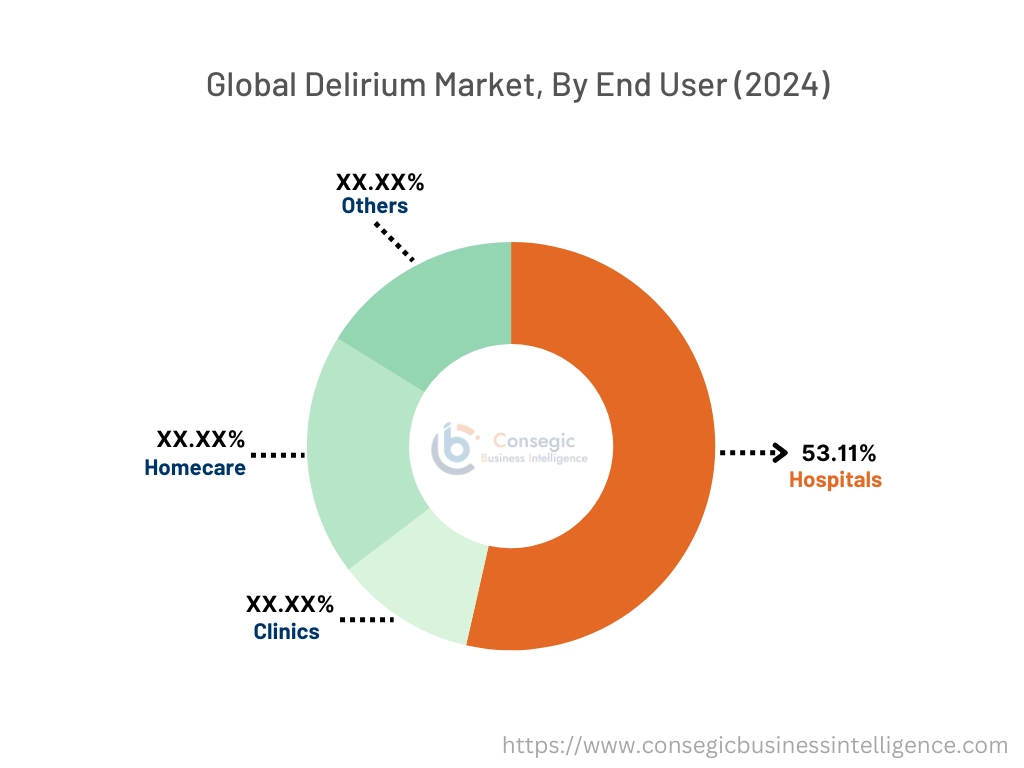
Regional Analysis:
The regional segment includes North America, Europe, Asia Pacific, the Middle East and Africa, and Latin America.
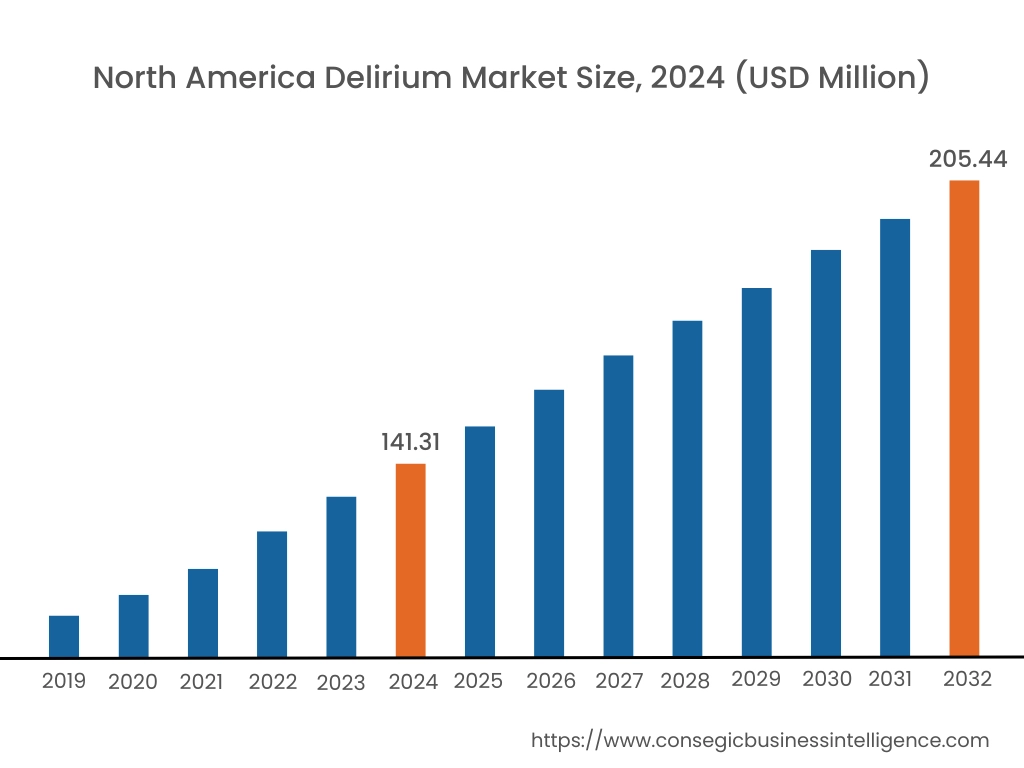
In 2024, North America accounted for the highest market share at 42.22% and was valued at USD 141.31 Million and is expected to reach USD 205.44 Million in 2032. In North America, the U.S. accounted for the highest market share of 70.99% during the base year of 2024. North America dominates the global delirium market, owing to the confluence of multiple factors such as the advanced healthcare infrastructure, high prevalence of chronic diseases, and a well-established pharmaceutical industry. Additionally, North America boasts a robust healthcare infrastructure with advanced diagnostic and treatment facilities, leading to timely intervention and improved patient outcomes. Moreover, the region's favorable reimbursement policies and government initiatives such as Medicare and Medicaid provide financial support for treatment, especially for vulnerable populations. Furthermore, government funding and initiatives supporting research and patient care further contribute to the market trajectory in this region.
- For instance, in October 2023, an interdisciplinary team of researchers, led by Penn State and Beth Israel Deaconess Medical Center (BIDMC), has been awarded a USD 3.8 million grant from the National Institutes of Health’s National Institute on Aging. This funding is awarded to enable the team to build upon previous research efforts, focusing on improving screening accuracy for delirium. This new initiative extends a screening investigation by integrating tools into medical/surgical units in three hospitals in Pennsylvania and Massachusetts.
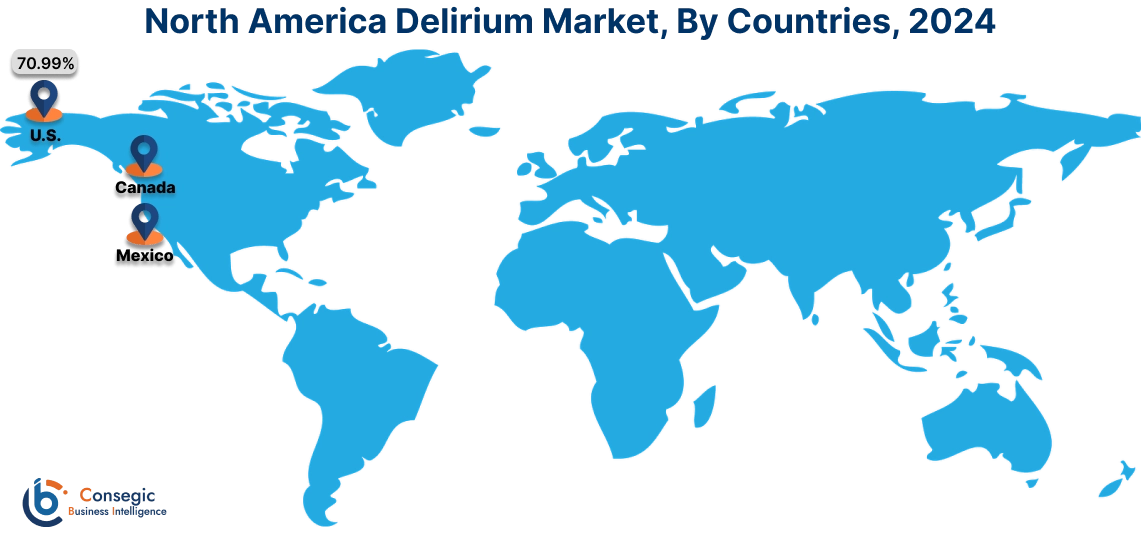
The combination of the aforementioned factors and trends is driving substantial growth in the North American market.
Asia Pacific is experiencing the fastest growth with a CAGR of 5.9% over the forecast period. The delirium market trend across the region is attributed to a significant and rapid demographic shift with a rapidly aging population, which increases the prevalence of age-related conditions, including those that increase the risk of delirium. Ongoing advancements in healthcare infrastructure, including enhanced access to healthcare facilities and improved diagnostic capabilities, are contributing to better disease detection and management across the region. Increased healthcare expenditures are driving improvements in healthcare infrastructure and access to healthcare services, including those related to the diagnosis and management of this condition. Furthermore, there's a growing awareness among healthcare professionals in the Asia-Pacific region about the significance of the condition, its impact on patient outcomes, and the importance of early identification and management, driving the adoption of best practices and the development of local guidelines for care further boosting the Asia Pacific market.
Europe presents a significant contribution to the delirium market analysis. Europe boasts a robust healthcare system with advanced infrastructure, including well-equipped hospitals and clinics, ensuring timely diagnosis and treatment of this condition. Additionally, many European countries have strong public healthcare systems that provide access to quality healthcare services, including those for delirium further propelling the market. Moreover, strong public health initiatives and high awareness among the population regarding this condition contribute to early detection and prompt treatment. A strong emphasis on patient-centered care across many European countries drives the development and implementation of best practices in prevention and management. Overall, as per analysis, the combination of accessible primary care, strong public healthcare systems, and advanced diagnostic facilities contributes to the effective management of this condition in Europe, ultimately driving the market trend.
The Middle East and Africa (MEA) region is witnessing notable Delirium market trends. The growing healthcare sector in the Middle East is playing a pivotal role in demand. Many countries in the MEA region are investing in developing their healthcare infrastructure with advanced diagnostic and treatment facilities. This includes building hospitals, and clinics, and improving access to diagnostic tools which are essential for detecting this condition. The combined impact of these factors is creating a favorable environment for the trajectory of the delirium market opportunities in the MEA region.
Latin America is an emerging region in the delirium market share, with significant potential for innovation. The combination of the increasing prevalence of chronic disorders, government support, and rising disposable income is driving the significant growth of the delirium market demand in Latin America. The region encompasses a mix of public and private healthcare systems, with varying levels of access and affordability. This diversity impacts the availability and utilization of diagnostic and treatment options. The growing middle class in several Latin American countries has led to increased healthcare spending and demand for quality treatments, including those for delirium. These factors collectively present a promising factor for healthcare providers and pharmaceutical companies’ manufacturers to develop and deliver innovative solutions to address the needs of individuals with this condition in Latin America.
Top Key Players and Market Share Insights:
The Delirium market is highly competitive with major players providing precise products to the national and international markets. Key players are adopting several strategies in research and development (R&D) and product innovation to hold a strong position in the global Delirium market. Key players in the market include-
- Ceribell, Inc. (U.S.)
- Koninklijke Philips N.V. (Netherlands)
- Pfizer (U.S.)
- AbbVie Inc. (U.S.)
- Sanofi (France)
- Teva Pharmaceuticals (Israel)
- Viatris Inc. (U.S.)
- Sandoz Inc. (Switzerland)
- Apotex Inc. (Canada)
- Johnson & Johnson (U.S.)
Recent Industry Developments :
Product Launches:
- In September 2022, Ceribell, Inc, announced that it received Breakthrough Device Designation for its delirium indication from the United States Food and Drug Administration. A first-of-its-kind technology, the Ceribell system utilizes machine learning to analyze electroencephalography signals to detect the condition.
Delirium Market Report Insights :
| Report Attributes | Report Details |
| Study Timeline | 2019-2032 |
| Market Size in 2032 | USD 500.39 Million |
| CAGR (2025-2032) | 5.2% |
| By Condition Type |
|
| By Type |
|
| By End-User |
|
| By Region |
|
| Key Players |
|
| North America | U.S. Canada Mexico |
| Europe | U.K. Germany France Spain Italy Russia Benelux Rest of Europe |
| APAC | China South Korea Japan India Australia ASEAN Rest of Asia-Pacific |
| Middle East and Africa | GCC Turkey South Africa Rest of MEA |
| LATAM | Brazil Argentina Chile Rest of LATAM |
| Report Coverage |
|
Key Questions Answered in the Report
How big is the Delirium market? +
In 2024, the Delirium market is USD 334.69 Million.
Which is the fastest-growing region in the Delirium market? +
Asia Pacific is the fastest-growing region in the Delirium market.
What specific segmentation details are covered in the Delirium market? +
Condition Type, Type, and End User segmentation details are covered in the Delirium market.
Who are the major players in the Delirium market? +
Ceribell, Inc. (U.S.), Koninklijke Philips N.V. (Netherlands), and Teva Pharmaceuticals (Israel) are some of the major players in the market.
